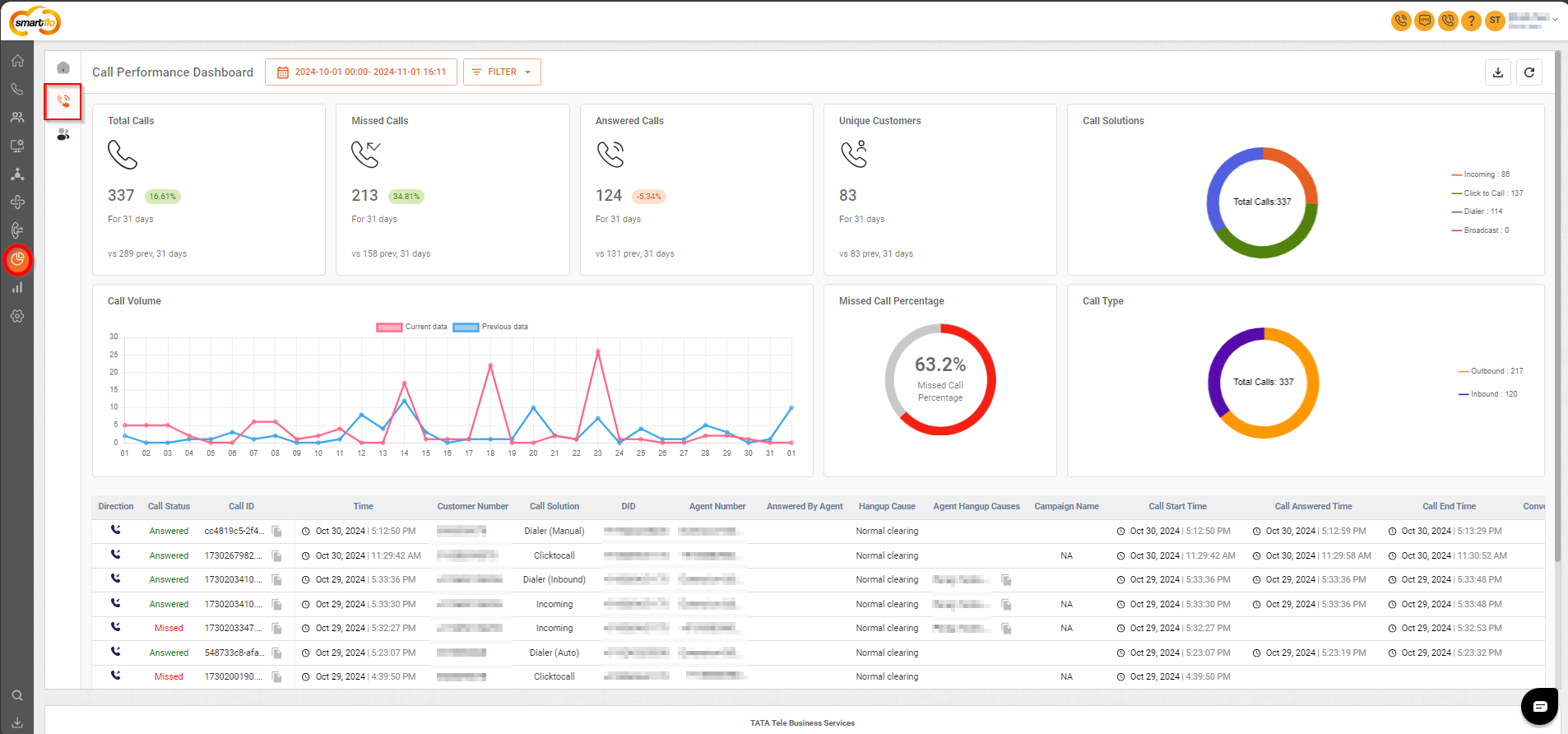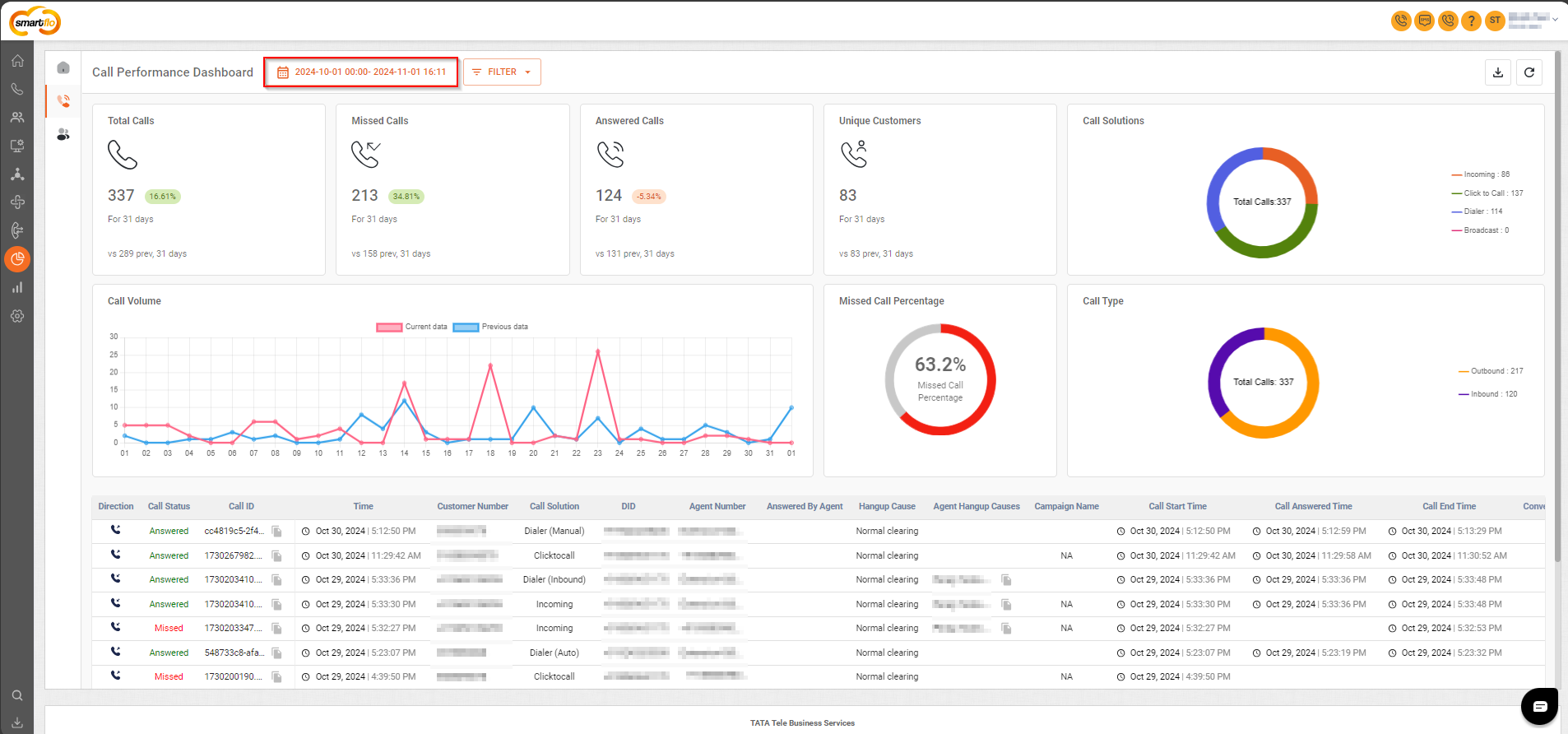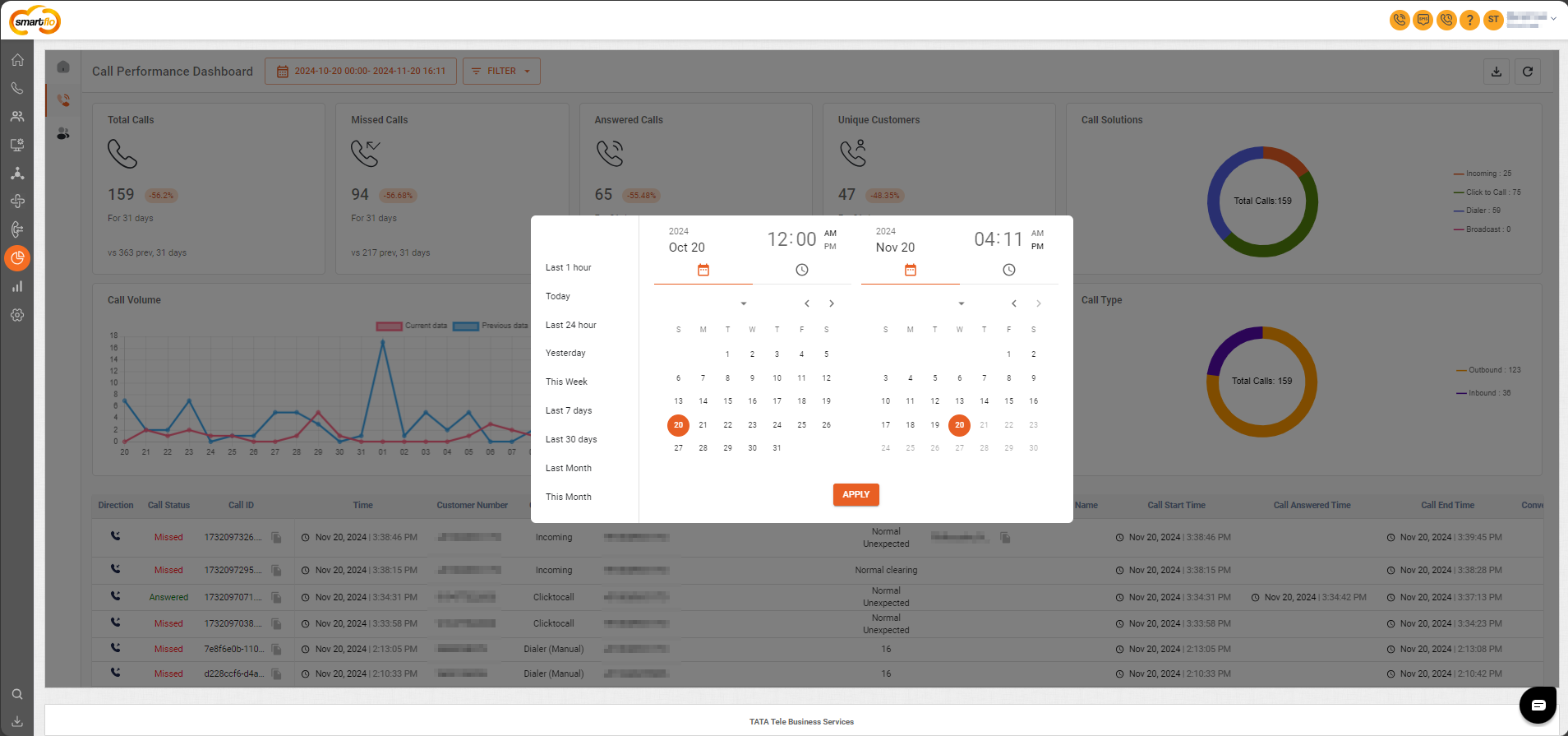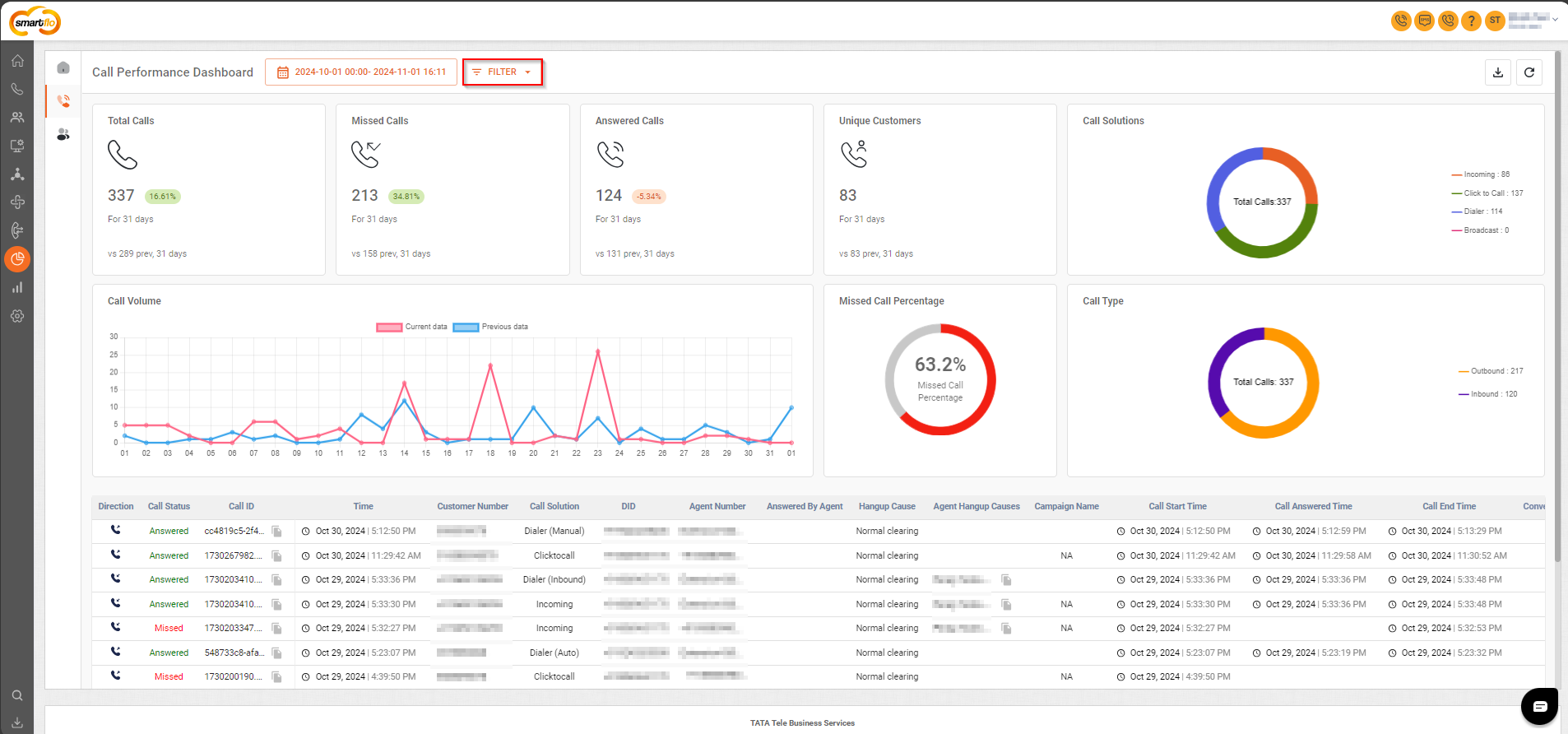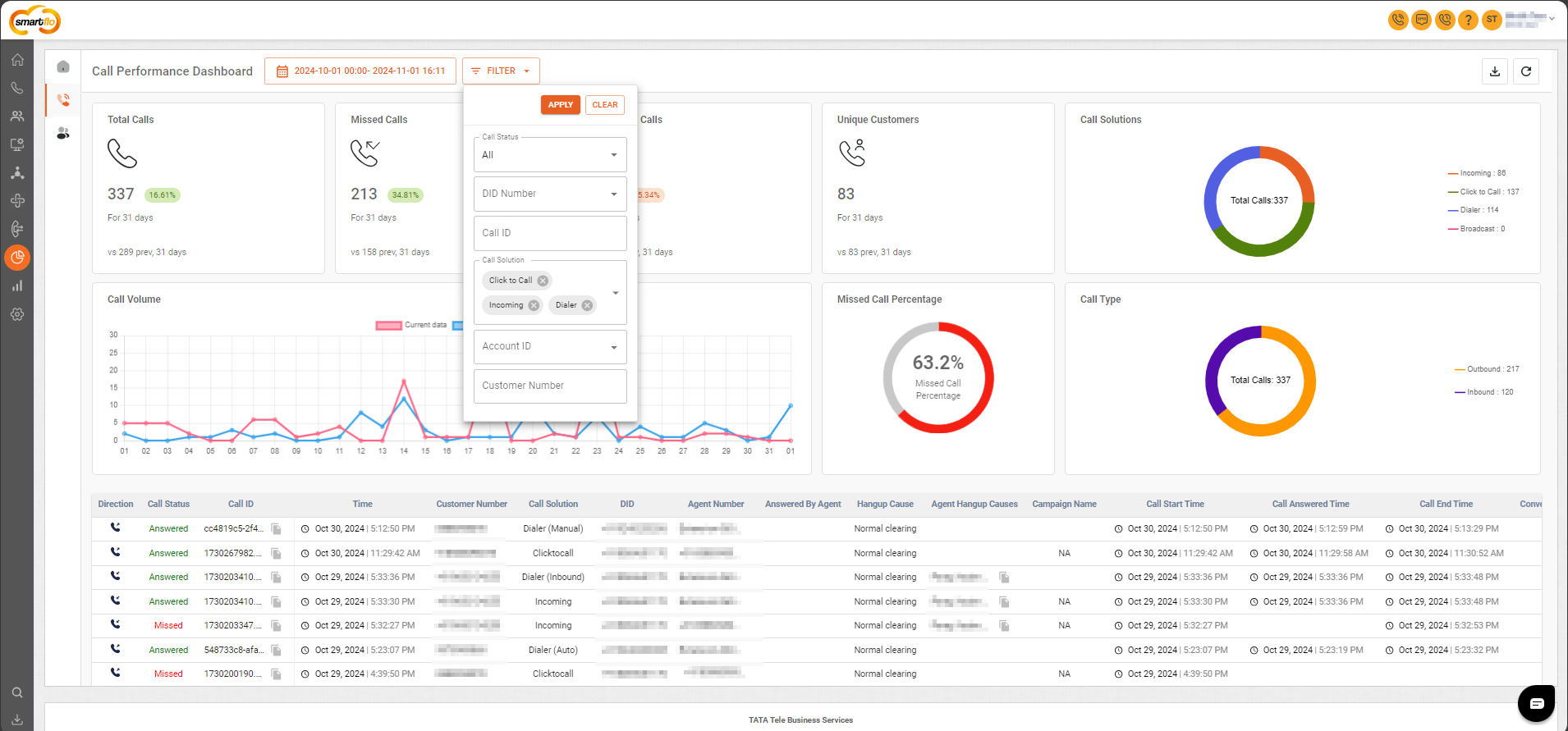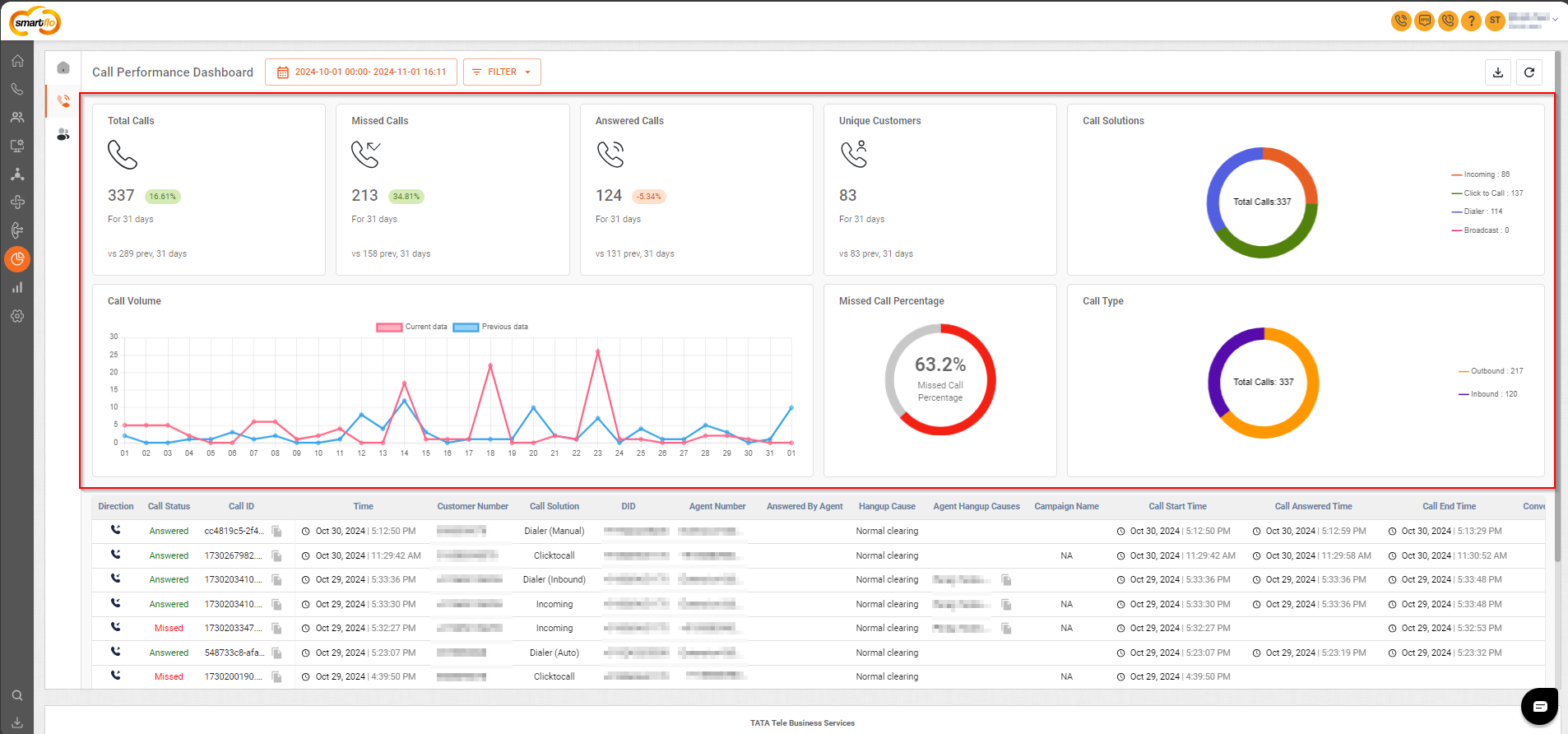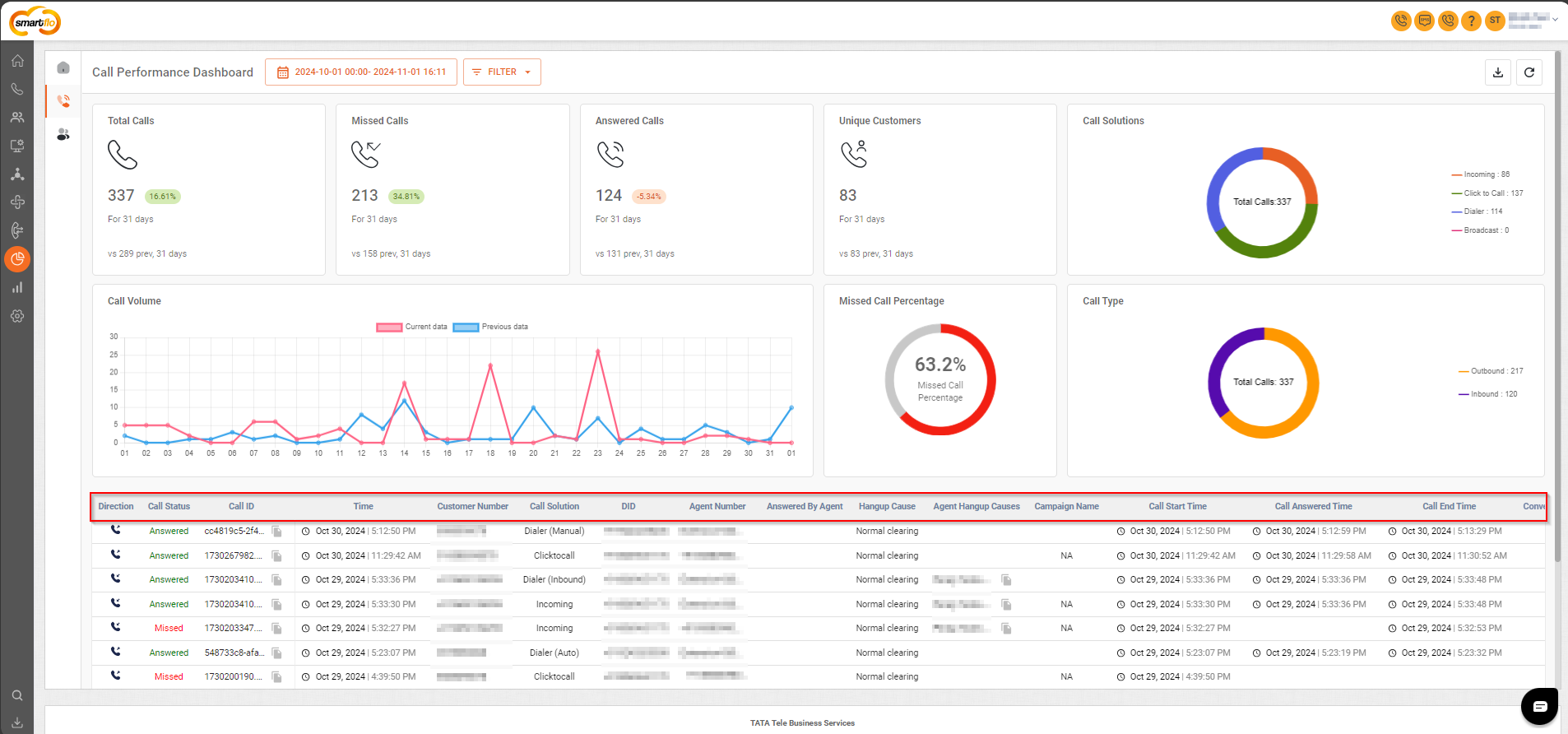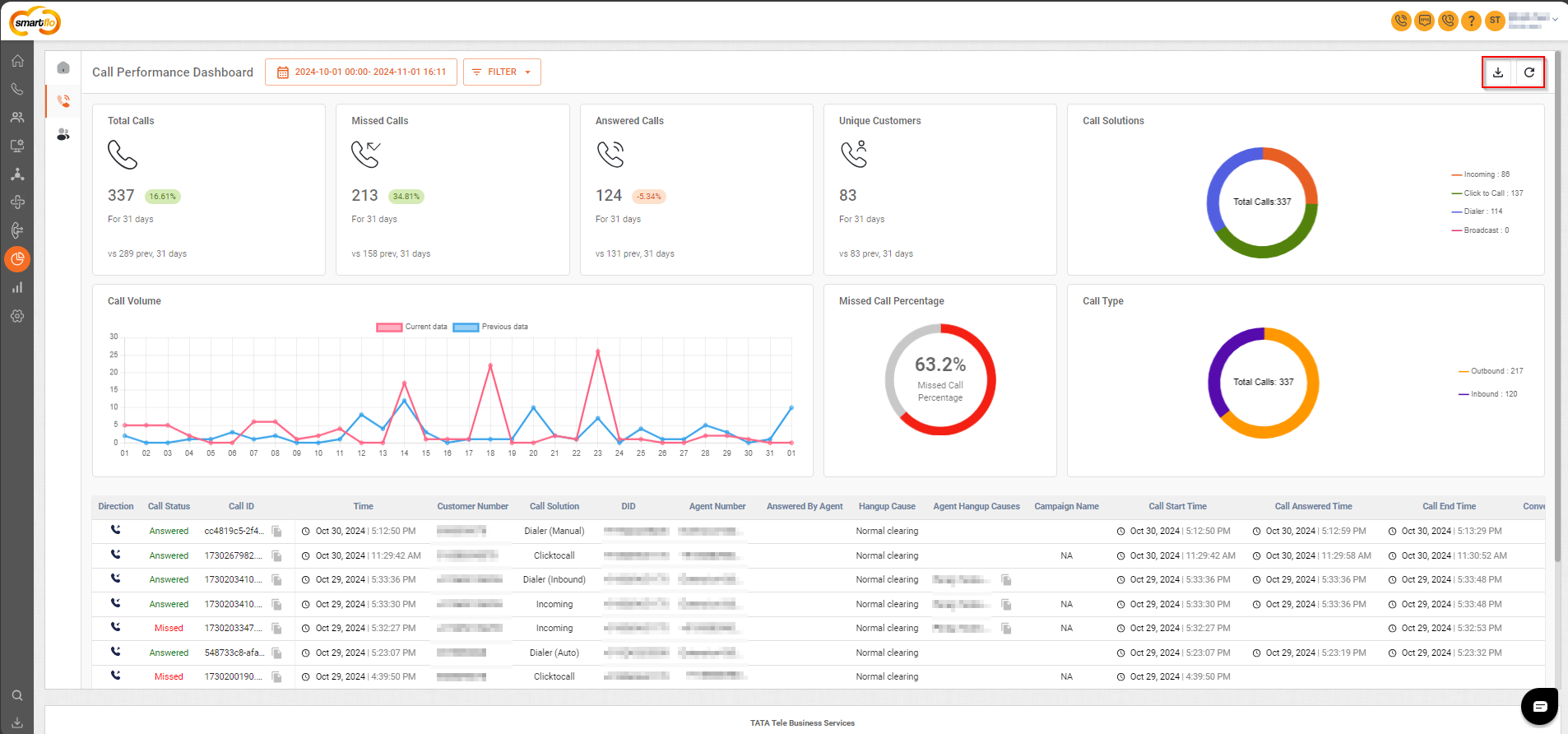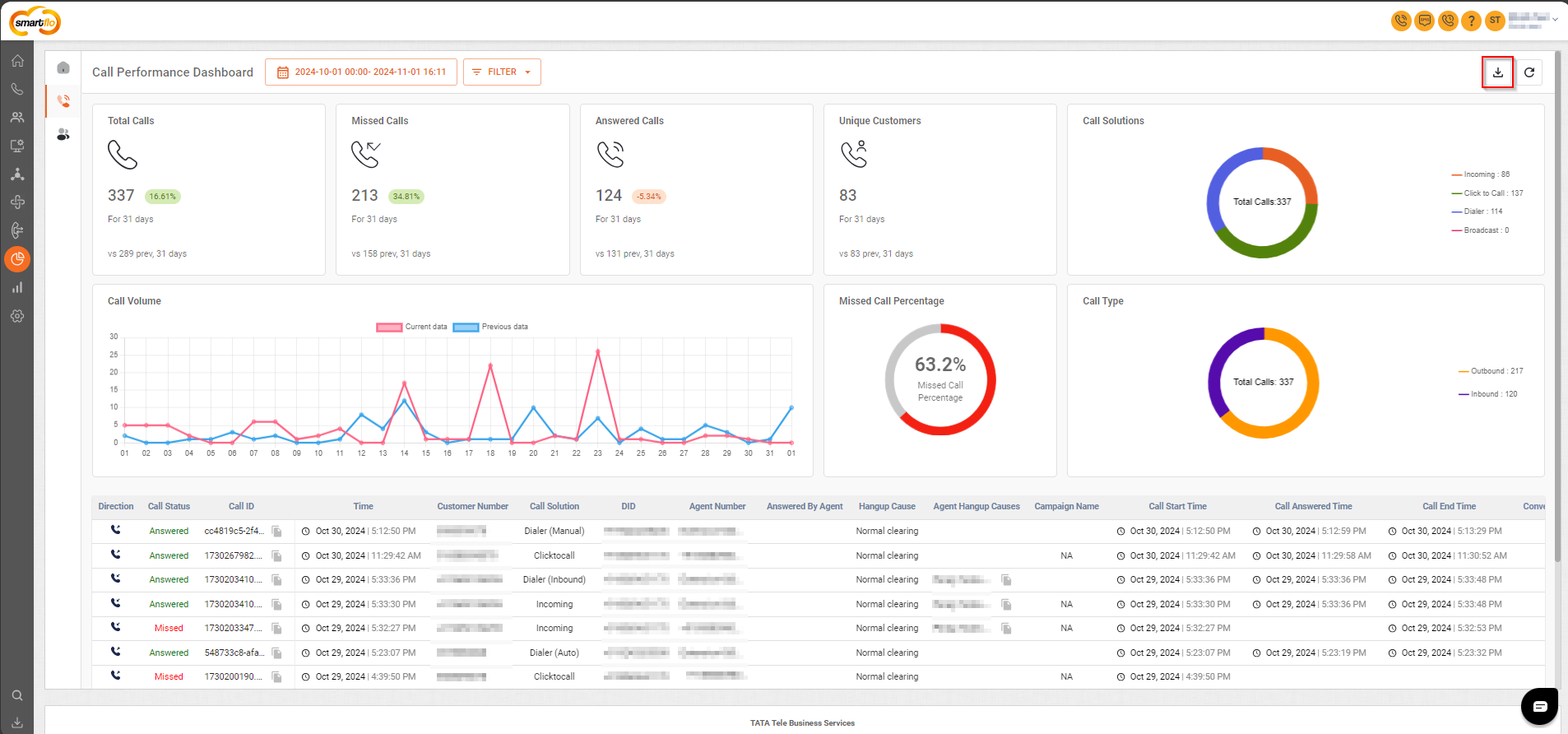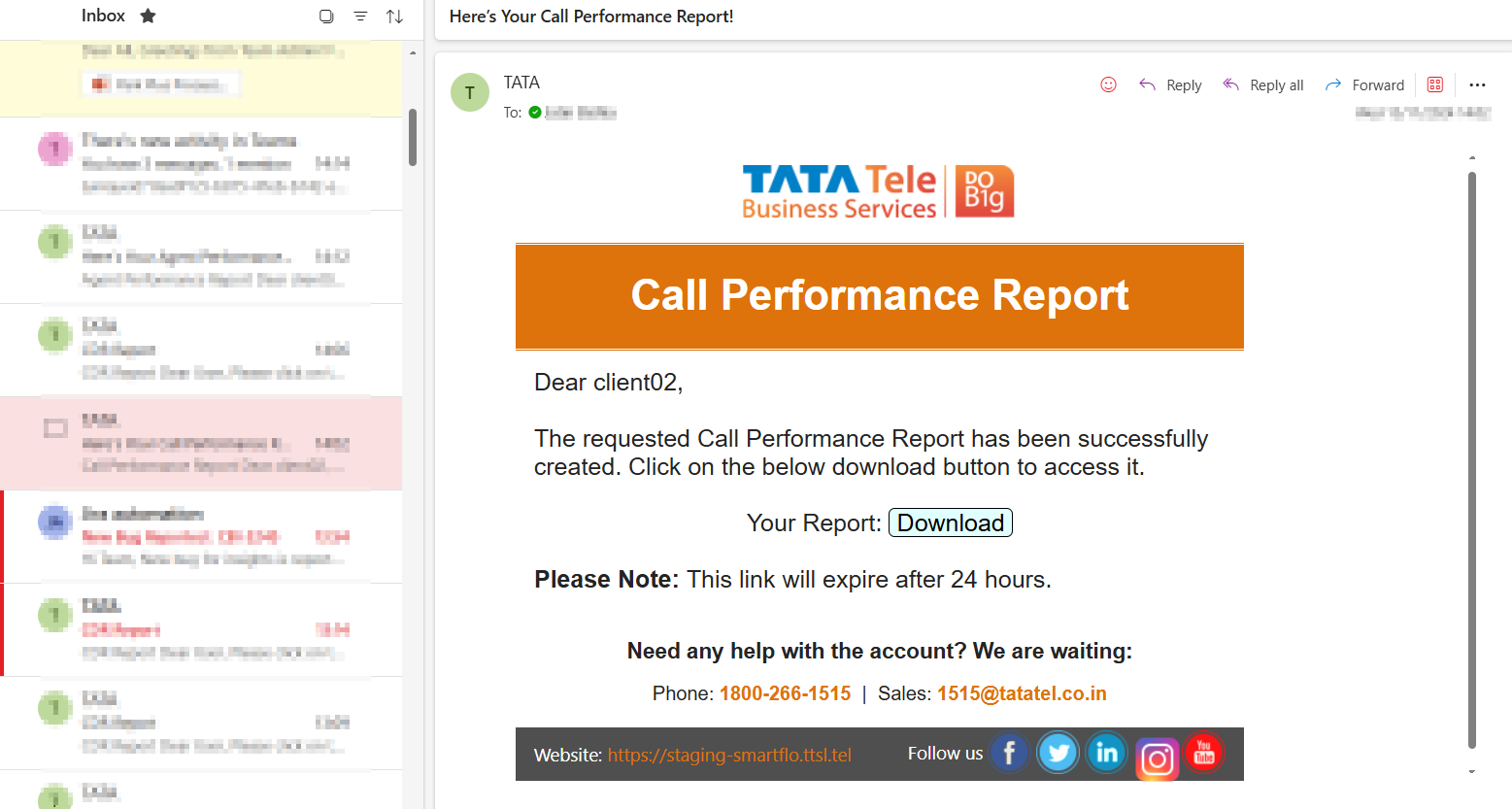Direction | Indicates whether the call was inbound or outbound. |
Call Status | The status of the call, such as Answered or Missed. |
Call ID | A unique identifier assigned to each call. |
Timestamp | The time when the call occurred. |
Customer Number | The phone number of the customer. |
Call Solution | The product that initiated or managed the call (e.g., Dialer, Click-to-Call) |
DID | The DID number used for the call. |
Agent Number | The phone number or extension of the agent handling the call. |
Answered By Agent | Specifies the name of agent who answered the call (if any). |
Hangup Cause | Represents the cause of the hangup call, like ‘normal clearing’.
- Call awarded delivered
- Normal unexpected
- User busy
- No user response
- No answer
- Subscriber absent
- Call rejected
- Number changed
- Destination out of order
- Invalid number format
- Facility rejected
- Response to status enquiry
- Normal unspecified
- Normal circuit congestion
- Network out of order
- Normal temporary failure
- Switch congestion
- Access info discarded
- Requested channel unavailable
- Preempted
- Facility not subscribed
- Outgoing call barred
- Incoming call barred
- Bearer capability not authorized
- Bearer capability not available
- Bearer capability not implemented
- Channel not implemented
- Facility not implemented
- Invalid call reference
- Incompatible destination
- Invalid message unspecified
- Mandatory IE missing
- Message type does not exist
- Wrong message
- IE does not exist
- Invalid IE contents
- Wrong call state
- Recovery on timer expire
- Mandatory IE length error
- Protocol error
- Interworking
- Number in DND
- Outbound calls are blocked for this agent
|
Agent Hangup Cause | Indicates the reason why the agent ended the call.
- Call awarded delivered
- Normal unexpected
- User busy
- No user response
- No answer
- Subscriber absent
- Call rejected
- Number changed
- Destination out of order
- Invalid number format
- Facility rejected
- Response to status enquiry
- Normal unspecified
- Normal circuit congestion
- Network out of order
- Normal temporary failure
- Switch congestion
- Access info discarded
- Requested channel unavailable
- Preempted
- Facility not subscribed
- Outgoing call barred
- Incoming call barred
- Bearer capability not authorized
- Bearer capability not available
- Bearer capability not implemented
- Channel not implemented
- Facility not implemented
- Invalid call reference
- Incompatible destination
- Invalid message unspecified
- Mandatory IE missing
- Message type does not exist
- Wrong message
- IE does not exist
- Invalid IE contents
- Wrong call state
- Recovery on timer expire
- Mandatory IE length error
- Protocol error
- Interworking
- Number in DND
- Outbound calls are blocked for this agent
|
Campaign Name | The name of the campaign associated with the call, which will only be available in the case of Broadcastand Dialercalls. |
Call Start Time | The time when the call started. |
Call Answered Time | The time when the call was answered. |
Call End Time | The time when the call ended. |
Conversation Duration | The total amount of time the actual talk happened from customer.
- *Calculation:** Conversation Duration is = (Call End time Stamp- Call Answered time stamp)
|
Call Duration | The total duration of the call, including ringing time. |
Missed By Agent(s) | Indicates which agents missed the call (if the call was missed by an agent). |
Recording File Name | The file name of the call recording, if applicable. |
Recording | Provides a player to listen to the recording of the call. |
SIP Response Code | The SIP protocol response code for the call. |
Reason Key | The reason for the call's success or failure.
- Call awarded delivered
- Normal unexpected
- User busy
- No user response
- No answer
- Subscriber absent
- Call rejected
- Number changed
- Destination out of order
- Invalid number format
- Facility rejected
- Response to status enquiry
- Normal unspecified
- Normal circuit congestion
- Network out of order
- Normal temporary failure
- Switch congestion
- Access info discarded
- Requested channel unavailable
- Preempted
- Facility not subscribed
- Outgoing call barred
- Incoming call barred
- Bearer capability not authorized
- Bearer capability not available
- Bearer capability not implemented
- Channel not implemented
- Facility not implemented
- Invalid call reference
- Incompatible destination
- Invalid message unspecified
- Mandatory IE missing
- Message type does not exist
- Wrong message
- IE does not exist
- Invalid IE contents
- Wrong call state
- Recovery on timer expire
- Mandatory IE length error
- Protocol error
- Interworking
- Number in DND
- Outbound calls are blocked for this agent
|
Circle | The telecom circle of the customer’s location.
- *Disclaimer:** The accuracy of this information may vary as customers can port their numbers to a different circle. The data is displayed based on the mobile number series originally owned by the telecom provider.
|
Operator | The telecom operator used by the customer.
- *Disclaimer:** The accuracy of this information may vary as customers can port their numbers to a different operator. The data is displayed based on the mobile number series originally owned by the telecom provider.
|
Call Scope | This indicates the geographical location of the call, specifying whether it is domestic or international.
- Domestic Call: A call made or received within the same country.
- International Call: A call made or received between different countries.
|
Auto Attendant | It will display the name of the auto-attendant that handled the call. |
IVR | It will display the name of the IVR that handled the call. If the call flow has multiple IVRs, there will be multiple names (all IVR names), separated by commas. |
Department | The department responsible for handling the call, which refers to the department where the call was routed. |
Voicemail | It will only display the name of the voicemail, only if it was created within the flow. |
Time Group | The time group associated with the call, which will display the name of the time group. |
Notes | Notes added by the agent regarding the call. |
Agent Ring Time | The time spent ringing on the agent's device.
- *Calculation:** Agent Ring Time= Answer Timestamp- Ring Start Timestamp
|
Lead ID | The identifier for the lead associated with the call. |
List ID | The identifier for the lead list used, which refers to the Campaign List ID (either for Broadcast or Dialer campaigns). |
List Name | The name of the Lead list used. |
Campaign ID | The identifier for the campaign associated with the call. |
Inbound Queue | The queue in which the call was placed for inbound calls (only for dialer). |
Wrap Up Duration | The time spent by the agent/user in wrapping up the call after the call was completed. |
Hold Duration | The total time the call was placed on hold during the entire call. |
Hold Count | The number of times the call was placed on hold. |
Retry Count | The number of retry attempts for the call. |
SLA Adherence | Indicates whether the call met SLA (Service Level Agreement) guidelines. (only valid for Dialer). |
Short Calls | Calls that ended after a very short duration. (If any inbound or outbound call duration is less than the defined SLA in the campaign then such calls are defined as short calls). |
Dialer Disposition | The status assigned to the lead by the agent |
Dialer Sub Disposition | The sub-category of the disposition |
First Call Resolution | Agent can mark the call as 'First Call Resolution' if the call has been resolved in the first attempt. |
Ring Duration | The total time the call spent ringing before being answered or disconnected. |
Listen To | Indicates whether the call was monitored (listened to). |
Listen To Duration | Total time spent by agent(s)/user(s)/admin(s) in listening to the call (monitoring). |
Listen By | The name(s) of the person(s) who monitored the call. If multiple agents/users listened to the call, it will display the names of all those individuals. |
Listen By Duration | The total time spent by the person monitoring the call. |
Whisper To | Indicates whether the whisper feature was used during the call. |
Whisper To Duration | The total duration of whispering during the call. |
Whisper By | The person who used the whisper feature during the call. |
Whisper By Duration | The time spent whispering by the person. |
Barge To | Indicates whether the call was barged. |
Barge To Duration | The total duration of the barge during the call. |
Barge By | The person who barged into the call. |
Barge By Duration | The time spent by the person barging into the call. |
